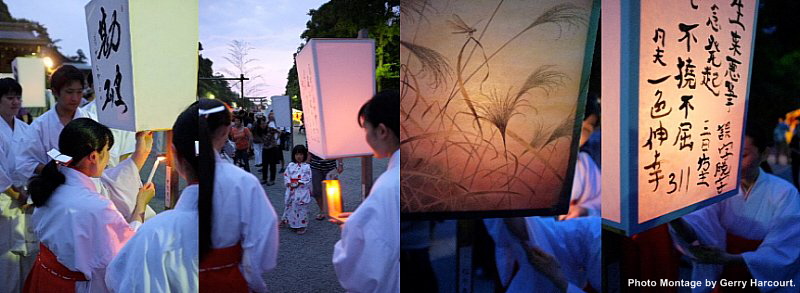|
LAST UPDATE: AUGUST 2011
CREATED BY ONMARKPRODUCTIONS.COM
Bonbori Matsuri (Lantern Festival) -- 139 Photos
Tsurugaoka Hachimangu Shrine, Kamakura, Japan

 Bonbori 雪洞 is a Japanese paper lantern. In early August each year, bonbori lanterns are lit in the sacred precincts of the Tsurugaoka Hachimangu Shrine in central Kamakura city. Other cities around Japan have similar lantern festivals. In Kamakura, lanterns are submitted by many artists, novelists and famous people. Roughly 400 bonbori with hand-drawn pictures, calligraphy, and poems are displayed in the shrine's precincts during the festival. Today, bonbori lanterns are commonly illuminated from within with electric bulbs, but sometimes (as in earlier decades) oil or candles furnish the lighting. The Kamakura Bonbori Festival began in 1939. Historically, bonbori lanterns were portable and distinctively hexagonal in shape, with wood or metal frames covered with paper (or glass in later years). They generally have poles attached horizontally to the frame for ease of transport. Click any image below to begin the slideshow. Some images are followed by a photo of the pole displaying the name of the artist. Bonbori 雪洞 is a Japanese paper lantern. In early August each year, bonbori lanterns are lit in the sacred precincts of the Tsurugaoka Hachimangu Shrine in central Kamakura city. Other cities around Japan have similar lantern festivals. In Kamakura, lanterns are submitted by many artists, novelists and famous people. Roughly 400 bonbori with hand-drawn pictures, calligraphy, and poems are displayed in the shrine's precincts during the festival. Today, bonbori lanterns are commonly illuminated from within with electric bulbs, but sometimes (as in earlier decades) oil or candles furnish the lighting. The Kamakura Bonbori Festival began in 1939. Historically, bonbori lanterns were portable and distinctively hexagonal in shape, with wood or metal frames covered with paper (or glass in later years). They generally have poles attached horizontally to the frame for ease of transport. Click any image below to begin the slideshow. Some images are followed by a photo of the pole displaying the name of the artist.

Lighting candles for the Kamakura bonbori festival. Above photo montage by Gerry Harcourt (longtime resident of Kita-Kamakura)
  
2011 Bonbori Matsuri (Latern Festival)
Tsurugaoka Hachimangu Shrine, Kamakura, Japan
All photos by Mark Schumacher unless specified otherwise.
2009 Bonbori Matsuri (Latern Festival)
Tsurugaoka Hachimangu Shrine, Kamakura, Japan
All photos by Mark Schumacher unless specified otherwise.
2008 Bonbori Matsuri (Latern Festival)
Tsurugaoka Hachimangu Shrine, Kamakura, Japan
All photos by Mark Schumacher unless specified otherwise.
2007 Bonbori Matsuri (Latern Festival)
Tsurugaoka Hachimangu Shrine, Kamakura, Japan
All photos by Mark Schumacher unless specified otherwise.
2006 Bonbori Matsuri (Latern Festival)
Tsurugaoka Hachimangu Shrine, Kamakura, Japan
All photos by Mark Schumacher unless specified otherwise.
2005 Bonbori Matsuri (Latern Festival)
Tsurugaoka Hachimangu Shrine, Kamakura, Japan
All photos by Mark Schumacher unless specified otherwise.
OTHER RESOURCES ON JAPANESE LANTERNS
- Japanese Stone Lanterns, Offerings of Light
https://www.onmarkproductions.com/html/ishidoro.shtml
- Tōrō 灯籠 (Japanese Laterns)
https://www.aisf.or.jp/~jaanus/deta/t/tourou.htm
Also written 灯篭. A lantern. The earliest were introduced to Japan from China through Korea along with Buddhism in the 6th century. Several types of lanterns were popular in Japan:
- Stone lanterns, ishidōrō (ishidoro) 石灯籠, were used first as votive lights at temples and shrines. Later they were used to light the ground of these religious precincts. Secular use began in the 16th c. when stone lanterns were used by tea masters for gardens surrounding their tea huts. There are about nine major categories of stone lanterns based on general shapes and over 75 sub-categories. All include a hollowed-out upper section which hold a light.
- Hanging metal lanterns, tsuridōrō (tsuridoro) 釣灯籠, usually of bronze or iron, were hung from the corner eaves at palatial residences, temples and shrines.
- Standing oil lanterns, andon 行灯, had iron or wood frames. There were many different shapes and sizes which burned oil in shallow saucers suspended within a frame covered with paper. This type of lantern became popular during the Edo period and was used in private homes.
- Portable lanterns, bonbori 雪洞, were distinctively hexagonal, with wood or metal frames covered with paper, or glass in later years. They generally had poles attached horizontally to the top of the frame for ease of transportation.
- Paper lanterns, chōchin (chochin) 提灯, were used outside the house and suspended from the eaves of buildings or carried in processions. The frame was a collapsible structure of thin bamboo strips covered with paper. A candle was placed inside. Chōchin were made in various sizes, shapes and colors and were often decorated with the names or logos of restaurants or inns.
- Bonbori Definition from Wikipedia
https://en.wikipedia.org/wiki/Traditional_lighting_equipment_of_Japan
The bonbori 雪洞 was a small, portable andon 行灯 with a six-sided cross-section and a rather wide, open top. Like the andon, it consisted of paper over a frame. The traditional lighting equipment of Japan includes the andon, the bonbori, the chōchin 提灯, and the tōrō 灯篭.
- Chūkei and Onatsu-sen
https://worldkigodatabase.blogspot.com/2005/06/fan-oogi-and-uchiwa.html
Ceremonial fans for monks. The chūkei (chukei) 中啓 is a fan whose head part is wider than its grip part when folded. A bonbori is a simplified form of chūkei and is mainly used by Buddhist missionaries. The onatsu-sen 御夏扇 was designed as a daily-use fan and its head part is unfolded to only about half the size of a chūkei.
CREATED BY ONMARKPRODUCTIONS.COM
|